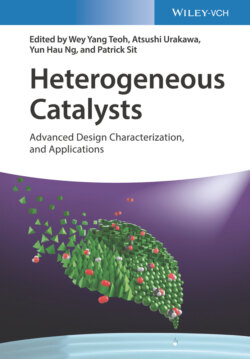Читать книгу Heterogeneous Catalysts - Группа авторов - Страница 48
4.2.2.1 Graphene or rGO as Starting Material
ОглавлениеGraphene has a number of favorable properties as catalyst support compared to other carbon materials. Graphene has a theoretical specific surface area as high as ∼2600 m2/g, which is twice that of single‐walled CNTs and much higher than those of most carbon blacks and activated carbons. This structure makes graphene highly desirable for potential applications as a 2D support for loading metal catalysts. The absence of micropores favors accessibility of reactants and desorption of products. Moreover, the locally conjugated structure endows graphene with enhanced adsorption capacities toward nonpolar aromatic substances, which can be beneficial for catalytic reactions involving such compounds. In contrast, graphene has low wettability in polar solvents, rendering aqueous‐phase impregnation forbidden. Graphene materials can be obtained at a relatively low cost on a large scale by using graphite or graphite oxide and its derivatives as starting materials. The catalyst preparation can start from graphene or from GO that is subsequently reduced to rGO. The graphene materials are free from the metallic impurities that are almost inevitably present in CNTs, which is one of the drawbacks of the latter as catalyst supports. The superior electron mobility of graphene can facilitate efficient electron transfer during the catalytic reactions, thereby improving its catalytic activity. Finally, graphene has also high chemical, thermal, optical, and electrochemical stabilities, which can possibly improve the durability of the catalysts.
A wide variety of methods, such as hydrothermal procedure and microwave‐assisted heating, have been developed for the synthesis of metal nanoparticles supported on graphene sheets. To prepare the supported noble metal nanoparticles, hydrazine, NaBH4, and ethylene glycol are generally used as reductants. For transition‐metal nanoparticles (Fe, Co, Mn), NaOH or aqueous ammonia is often used to hydrolyze metal salts (to metal hydroxide precipitates). Sometimes, reduction is carried out under high pressures using supercritical water or CO2 where the graphene support would act as a reductant (carbothermal reduction). Although small noble metal clusters (< 2 nm) could be formed directly on rGO without adding any reductant or capping agent [10], the alternative is to presynthesize the fine nanoparticles using the organometallic approach, and followed by the deposition on rGO and removal of capping agents.
TrGO tends to have higher concentration of defective (heteronuclear) sites, which turns to be beneficial as the adsorption sites for metal cations. With its mildly reducing behavior, the rGO sheets subsequently act as electron donors for metal clusters to grow on its surface. The formation of small clusters only occurs when using rGO with low density of heteronuclear sites, where nucleation sites are distanced adequately. If the GO substrate is not sufficiently reduced, the rGO contains excessive nucleation sites and results in large nanoparticles. In a recent work [11], the reducing potential of graphite intercalation compounds (GICs) as precursors for graphenide solutions is used to deposit transition‐metal nanoparticles and metal oxides on graphene under mild conditions and without the use of other reductants. Small Fe nanoparticles (2–5 nm) were prepared by this method.
In general, the main problem encountered when using graphene as a catalyst support is that the basal planes lack the anchoring points for the metal and the metal sinters in the subsequent treatments of removal of capping agents or reduction. A nonpolar solvent or a mildly polar solvent is preferred for impregnation of the metal precursor. The advantage is that graphene is intrinsically reductive (albeit mildly) to circumvent the use of reductants. Sometimes, sacrificial stabilizing agents such as metal oxides are used to prevent the sintering of nanoparticles during thermal treatment [12]. Another option is to use GO to anchor a metal precursor and reduce both GO and the metal precursor simultaneously, i.e. GO reduced to rGO and metal precursor to metal nanoparticles. This approach is explained in Section 4.2.2.2.
